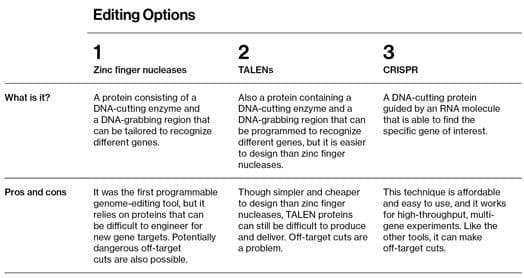CRISPR Genome Editing from Editas
Table of contents
Table of contents

Dr. George Church, is a Professor of Genetics at Harvard and widely considered to be a pioneer in synthetic biology. In previous articles, we have highlighted companies he is involved in including genome interpretation company Knome which he co-founded and Joule, a synthetic biology company producing diesel fuel and ethanol directly from sunlight, where he sits as a technical adviser. Another company in which George Church co-founded, Editas, has recently started coming out of stealth mode and is looking to edit, remove or fix genes in human cells.
About Editas
Founded in 2013, Boston based Editas has taken in $43 million in Series A venture capital financing led by leading health care venture capital firms Flagship Ventures, Polaris Partners and Third Rock Ventures with participation from Partners Innovation Fund. Editas was founded by five world leaders in the fields of genome editing, protein engineering, and molecular and structural biology; George Church, Feng Zhang, Jennifer A. Doudna, J. Keith Joung, and David R. Liu.
CRISPR
Just this past week, the Broad Institute of MIT and Harvard were awarded a key patent covering CRISPR, a new way of making precise, targeted changes to the genome of a cell or an organism. First used for genome editing in 2012, CRISPR is one of the most important genetic technologies developed in recent years. According to an article a few days ago by the MIT Technology Review, MIT, Harvard, and the Broad all jointly own the CRISPR patents. The Broad Institute’s technology licensing office will manage decisions about who will get licenses to use the technology. This should bode well for Editas since Fang Zheng, co-founder of Editas, is a core member of the Broad Institute. The article also mentioned that a spokesperson from Broad said that “specific details around licensing aren’t available at this time, but that Broad does intend to make this technology broadly available to scientists.” Editas is also working with a similar gene-editing method called TALENS. A comparison of three gene-editing techniques can be seen below:
Conclusion
In another MIT Technology Review article late last year, George Church stated that the technology’s ability to change single base pairs enables fundamentally new ways of thinking about gene therapy. Many inherited diseases, including cystic fibrosis and sickle-cell anemia, are caused by single base pair changes to the DNA sequence of genes, and the precise CRISPR technology could correct these mutations in patients. Editas has not made much mention about which diseases they plan to target first but their first rounding fund should give them plenty of capital to establish some suitable targets.
Sign up to our newsletter to get more of our great research delivered straight to your inbox!
Nanalyze Weekly includes useful insights written by our team of underpaid MBAs, research on new disruptive technology stocks flying under the radar, and summaries of our recent research. Always 100% free.

















Do Small investors have a chance of investing in Editas, or is this only for the big boys.if and when more funding is required is there a chance that one can invest.
Thank you for the comment Gerald. Editas had an IPO in February of this year. The ticker is EDIT.
I hope that Editas would pursue research with CRISPR Cas 9 and its potential to treat neurological disorders. I have an incurable malady, called spinal bulbar muscular atrophy (a.k.a “Kennedy’s Disease”), which leads to muscle and nerve degeneration. It effects my back and limbs; I have tremendous difficulty climbing stairs and ladders, and my quality of life has diminished. Do you think that gene editing may prove beneficial for me? Please advise. I would gladly volunteer for any clinical trials that you may initiate!
Hi Lamar,
Thank you for the comment. You’ll have to just stay close to the ongoing research as there is a lot to keep track of and we have just touched the surface. Human trials are only just beginning so treatments are likely a long ways away.